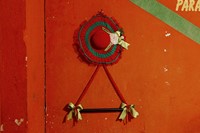Tinko Czetwertynski’s ongoing World of Interiores series is a playful, satirical nod to the glossy magazines that capture the precision-curated homes of the middle and upper classes
At first glance, Belgium-born photographer Tinko Czetwertynski’s series World of Interiores reads as a citrus-hued shoot from the pages of one of lifestyle publishing’s most coveted titles, but take a closer look and you’ll find yourself captivated by lived-in details that feel oddly familiar. From lurid plastic tablecloths and several generations worth of mismatched crockery, to flaking paint, ageing sandwich toasters and half-drunk liquor collections, Czetwertynski’s ongoing series captures the real homes of the Brazilian working class, sometimes photographed thousands of miles apart, but all demonstrating the same commitment to creating an expressive home with whatever is in reach.
Born in 1978 to a diplomat father, Czetwertynski’s life of travel has fuelled a deep curiosity for exploring ways of living on a global scale. Combining a desire to document his adventures and an art school education from London’s prestigious Central Saint Martins – where he studied BA Graphic Design with some focus on photography – the São Paulo-based creative has procured a sprawling portfolio of projects since he graduated in 2002, including work for lifestyle magazines, portraiture for private clients in the Arabian Gulf region and Brazil, and a documentation of his search for 12 spiritual masters around the world.
In World of Interiores, the audience is transported into the heart of each home. Kitchen dining tables appear sculptural in littered states and car garages take on the role of galleries, with mysteriously grouped chairs and a scattered offering of umbrellas, religious paraphernalia and vibrant tiles. On discovering and accessing these homes, Czetwertynski says, “I like to go into people’s houses and meet them, or peek inside when there’s an open window. Sometimes I see these scenes that are just really beautiful, with pastel colours and maybe something quirky or fun, but always with a nice touch.”

Optimism and ‘gambiarra’ – a Brazilian word that is used to describe a combination of resourcefulness and ingenuity – are at the heart of the series and can be seen in the eclectic curation of each space. “Brazilians really take care of themselves and of their houses,” adds the photographer. “Everything is always very clean, and there’s a lot of affection in it. Even in a very poor Brazilian house, they’ll make an effort to have a nice painting on the wall, or maybe a picture they’ve taken from a magazine. In every house, you’ll always see that they’ve given it some love.”
Czetwertynski’s playful, satirical nod to the glossy magazines that usually commission photographers like him to capture the precision-curated homes of the middle and upper classes reminds us that style can’t be bought, and that most of the trends we see in luxury interior design and architecture are rooted in the traditions, rituals and philosophies of those who will never be able to afford the resulting products. Authenticity – considered a high-value, hard-to-reach commodity in the creative world – is something the subjects of this series present in spades. “The main image from the cover of the series is, for me, a typical example of that,” states Czetwertynski. “If you look at it from a distance, it could be a villa in Capri, or some kind of rundown Sicilian Palazzo, but when you look closer there’s actually a curtain that’s a bit dirty and a plastic chair with a typical Amazonian setup, where there is a guy who has a house and a shop at the same time, with just this curtain between the two. The series is not questioning, but exploring what we consider as being valid in terms of style and taste and things like that. We can find inspiration anywhere, from very elaborate and exquisite places, but also in very simple places.”

Inspired by the regularity with which they feature in the homes he has photographed, and having lived in Brazil himself since 2010, the photographer cites a personal love of hammocks as a bi-product of shooting the series. “That’s something that I could not live without anymore,” he explains. “It’s my favourite piece of furniture. I think I have five hammocks in my house.” World of Interiores remains an ongoing project for Czetwertynski. “I’ve been doing it for a few years already and would like to publish a book with the material that I have now, then maybe do a second volume in a few years.”
World of Interiores by Tinko Czetwertynski is an ongoing series, and is currently displayed in the group show Back Home at Lamb Gallery, London, until August 6.






